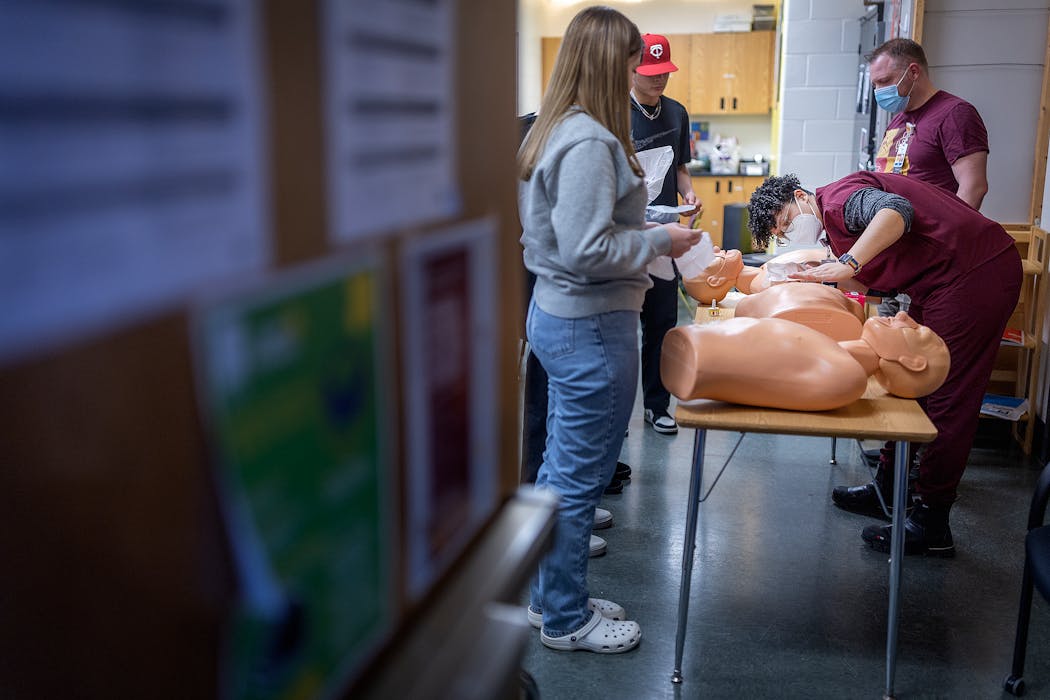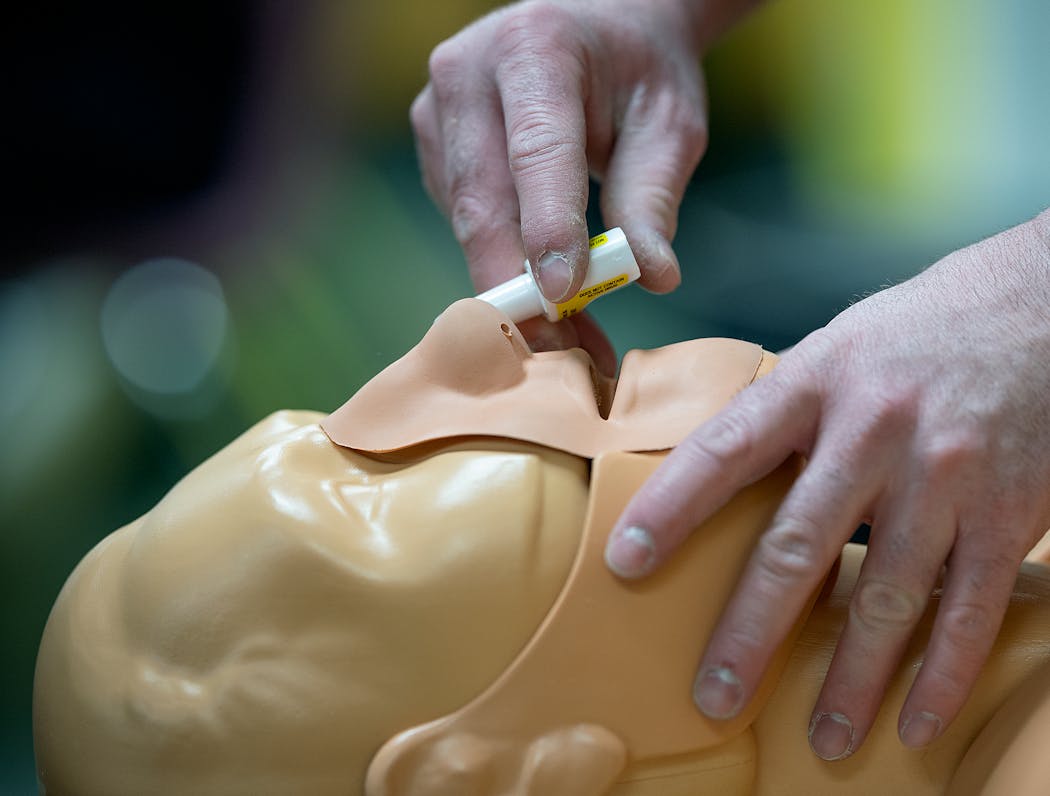High school senior Jorge Vargas and his classmates practiced slowly filling syringes and pressing the plunger of a nostril spray device, pretending the tools were filled with overdose-reversing naloxone.
A growing number of Minnesota school officials — and now some students, too — are learning how to respond to opioid overdoses as teen deaths from the drugs have climbed in recent years.
"With the opioid epidemic it's becoming more prevalent, especially amongst kids our age," said Vargas, who suggested the naloxone training course to his teacher at Washington Technology Magnet School in St. Paul after hearing about a similar course at Minneapolis' Roosevelt High School.
School districts and charter schools across the state must now keep a supply of naloxone, often known by the brand name Narcan. Legislators passed a law last year requiring each school building to be equipped with at least two doses of the lifesaving drug.
Officials with St. Paul Public Schools said they have administered naloxone twice since they started stocking it in schools last May. At two of Minnesota's other largest school districts, Minneapolis and Anoka-Hennepin, staff said they have not yet needed to administer naloxone since the new requirement.
The most recent available CDC death data shows that 46 Minnesota teens ages 15 to 19 died of a drug overdose in 2021. That's a sharp increase from fewer than 10 fatal teen overdoses in 2018.
It's difficult to track how often the opioid crisis surfaces in school halls, with data on overdoses and drug use on school grounds not readily accessible.
But Minneapolis Public Schools noted that they had 134 disciplinary incidents involving illegal drugs last school year. In one incident this fall at Minneapolis South High School, a behavior report notes a bathroom "smelled like fentanyl" immediately after a student exited and says the student also had that smell the following day after leaving the restroom.
Districts across Minnesota raced to ensure some staff, like school nurses, were trained on how to use the overdose reversal drug ahead of the school year. The state doesn't monitor which schools have naloxone or trained staff.
Minneapolis Public Schools trained school administrators and health office staff in August and also set up an online training that roughly 280 staff have completed so far, according to spokeswoman Mary Alice Rosko.
In St. Paul Public Schools, health and security staff have been trained on how to administer naloxone, spokeswoman Erica Wacker said. This month, she said, they will offer a virtual course for staff, who can choose to get naloxone to keep on hand once they complete the training. Some health classes are also adding opioid overdose and naloxone information to their curriculum, she noted.
Expanding that education to more students is critical, said Alicia House, executive director of the Steve Rummler Hope Network, which provides training and naloxone kits.
"Education, knowledge, awareness and hopefully resources to students would be the next step. There's no reason why we should be withholding naloxone, testing supplies or education from students," House said.
Fentanyl raises risk for teens
Colleen Ronnei, who leads the nonprofit Change the Outcome that does opioid education in schools, would also like to see naloxone on school buses and at athletics and other school-sponsored events. So far this school year, she has heard of three situations where naloxone was used in Minnesota schools.
There is a shift happening among some school administrators who used to resist Narcan training, fearing it would promote drug use, said Ingrid Johansen, M Health Fairview's director of community clinical care. She said more people understand "this is just an important part of emergency response until we get on the other side of this epidemic."
M Health Fairview and the Steve Rummler Hope Network have been training some high school students on how to respond to an overdose. Their next such session is in Princeton, about an hour north of the Twin Cities.
At Washington Technology Magnet School, about 120 students in the school's introduction to medical careers classes received the naloxone training, said teacher Meagan O'Brien, who was learning about administering the drug alongside the students.
"This is touching all communities," she said. "In the teen community there's experimentation, and I worry about kids."
The chance that other drugs could be laced with the powerful synthetic opioid fentanyl makes the stakes for experimentation much higher than they used to be, Johansen said.
"This dangerous fentanyl is so pervasive right now. Kids that have no idea what they are ingesting — it can take their life. So if someone happens to have a dose of rescue medicine in their backpack, that's amazing and that can buy someone time to get help," Johansen said, noting that during their seminar at Roosevelt High School, they gave every student who wanted one a nasal spray naloxone kit on their way out.
Schools add drug and alcohol counselors
Some school districts are also adding counselors to help students who are struggling with substance use or are affected by a family member or friend's use.
St. Paul Public Schools started a partnership with the Wilder Foundation this year where a counselor, peer recovery specialist and three interns visit four of the district's high schools. The Anoka-Hennepin School district added a second chemical health counselor at the start of last school year, while Minneapolis is expanding its ranks of licensed drug and alcohol counselors in schools where vaping is most common.
Last year, Josh Macomber was the lone licensed alcohol and drug counselor serving Minneapolis Public Schools.
"It was like trying to drink out of a firehouse," he said. Even if the district added one worker like him in every high school and had a couple serving middle schools, he said they would still be busy.
"There's a reason that the state decided to put Narcan in every school," Macomber said. "And I think that, in and of itself, suggests that it is kind of a clear and present danger."
Staff writer Mara Klecker contributed to this report.
New Minnesota GOP leaders seek peace with party's anti-establishment wing

Who is Republican Lisa Demuth, Minnesota's first House speaker of color?

Minnesota House GOP, Secretary of State Steve Simon return to Supreme Court
Supreme Court sides with DFL and Simon, says 68 House members needed for floor action





